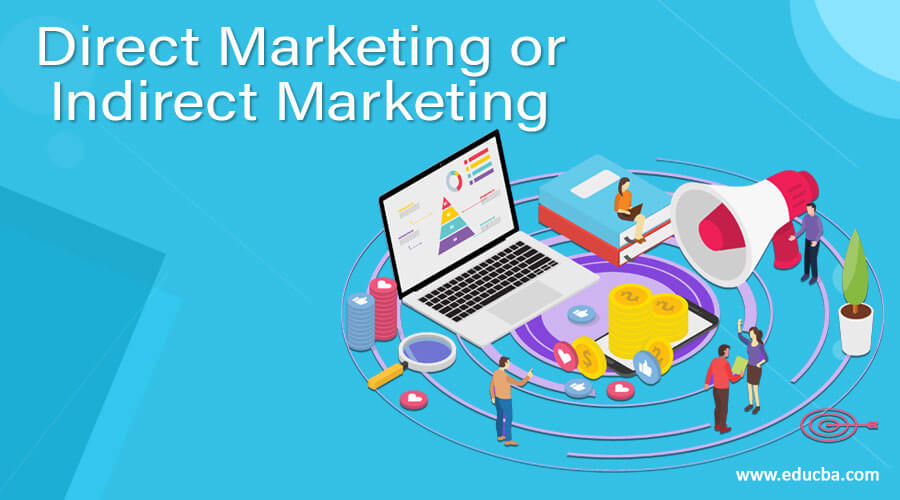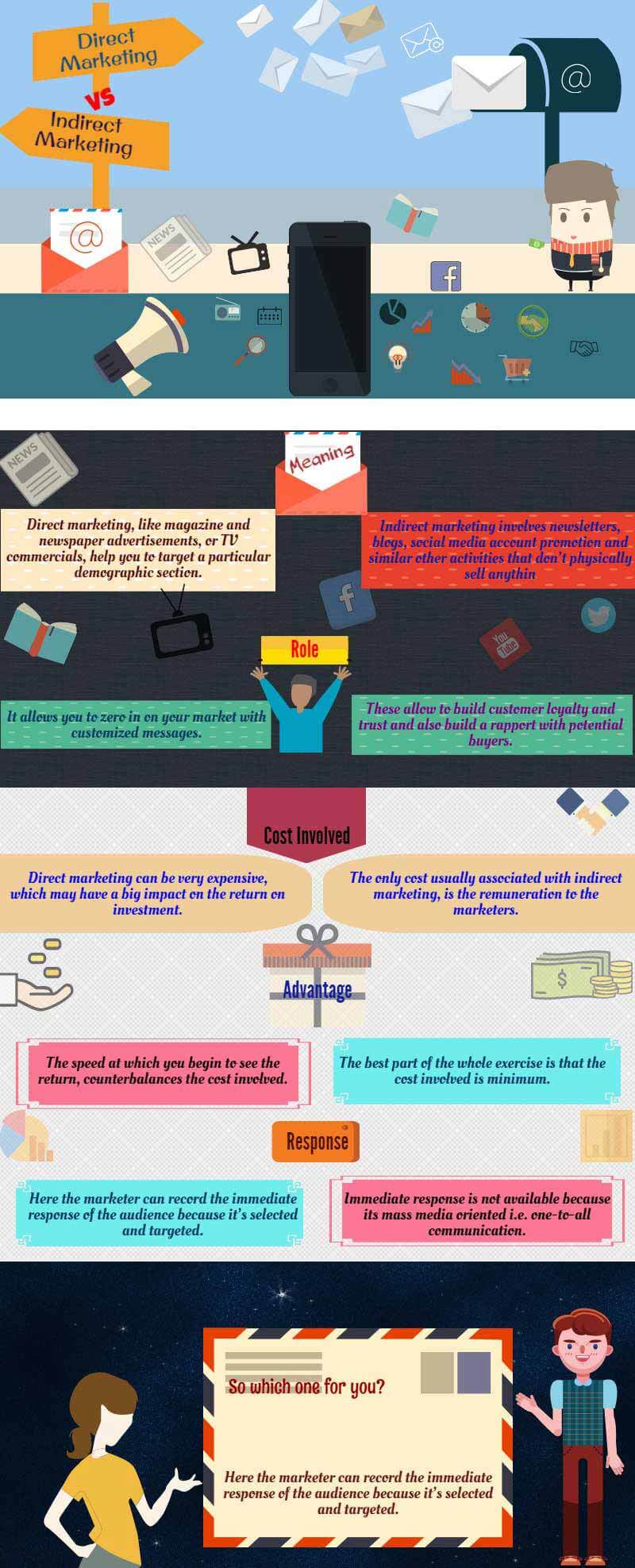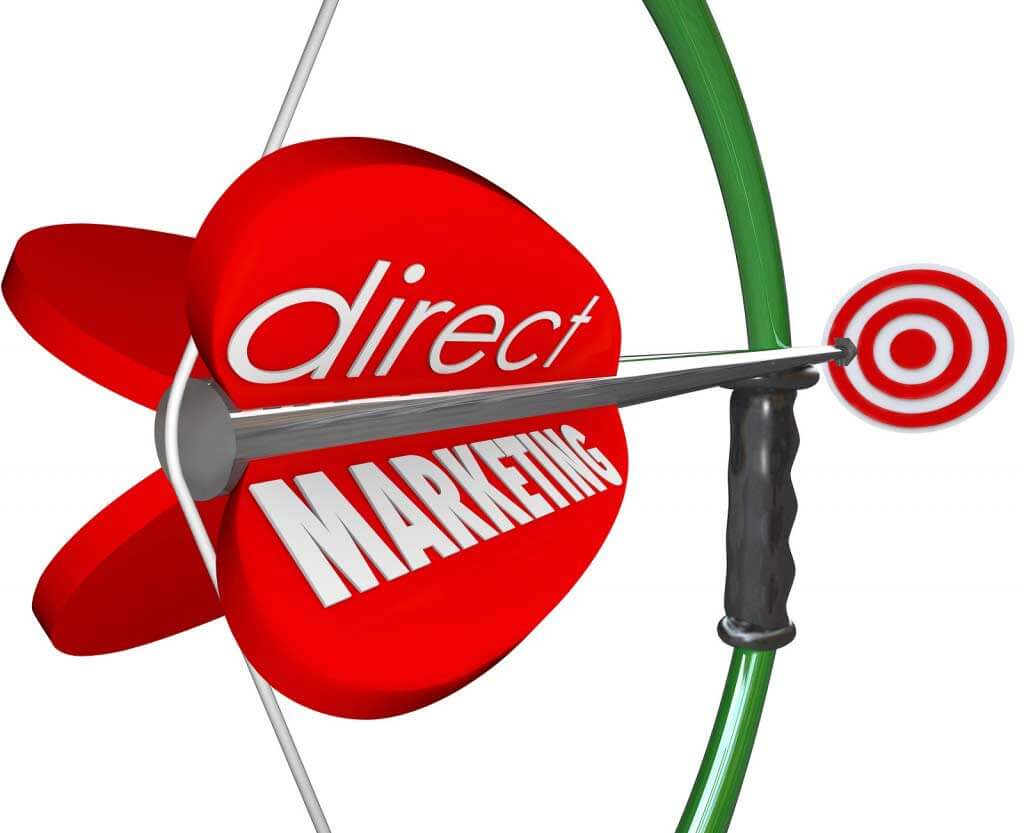Updated July 28, 2023
Difference Between Direct Marketing or Indirect Marketing
Direct Marketing vs. Indirect Marketing requires a serious analysis to understand. Both systems originate from the marketing communication method called “promotion”. The most important point in marketing is communication between the buyer and the seller. There’s a high chance of misunderstanding between the two sides, eventually leading to chaos in the marketplace. Let’s examine the difference and how they can be combined to reap the benefits.
Head-to-Head Difference Between Direct Marketing vs. Indirect Marketing (Infographics)
Below is the Head to Head Difference Between Direct marketing vs. Indirect marketing.
Direct marketing
Direct marketing, like magazine and newspaper advertisements, or TV commercials, helps you to target a particular demographic section with a sales pitch, especially built for them. But do we get the information required to build these marketing campaigns? Even not so long ago, companies would spend huge amounts of money conducting market research in person or on the telephone.
That’s no longer the case, with the internet becoming the de facto channel for information. Besides the advent of the personal computer and easy access to the internet via smartphones and tabs, direct marketing research no longer requires any exorbitant amount of money. All the information is available at the click of a mouse button.
Conventional marketing has spawned the creation of various indirect marketing tactics, but it doesn’t mean they can’t be used together. In fact, combining the two approaches provides important information you have collected from the indirect techniques to use in direct marketing campaigns later.
What can direct marketing do?
Direct marketing techniques like TV and magazine advertisements, telemarketing, and billboards, allow you to zero in on your market with customized messages.
There are, of course, some downsides to this method, though. The cost factor is one of the most obvious of them all. Direct marketing can be expensive and impact the return on investment, particularly if you own a small business.
But the speed at which you begin to see the return counterbalances the cost of developing and running the campaigns. The returns can be measured easily if the campaigns are well-made and warmly received.
But how does one ensure that their campaigns align with the target audience? Earlier, companies spent thousands of dollars on market research on what customers they wanted. The campaigns were often carried out only to increase customer trust in the brand.
This, however, is not the case anymore. People nowadays want their business to be service-oriented, often making or breaking a buyer-seller relationship. With the internet and social media, it’s cheaper and easier than earlier to forge a relationship with your customer.
All it takes is a team, or some individual, using indirect marketing methods to collect the information required to create a campaign for the chosen customer section.
Indirect marketing: Focusing on customer rapport
Indirect marketing involves newsletters, blogs, social media account promotion, and other activities that don’t physically sell anything. These allow a business to build customer loyalty, trust, and a rapport with potential buyers by not going for ambush marketing when interacting with you.
A positive interaction over the social media platform could convert your audience from probable customers to brand evangelists. Indirect marketing can lead to this and, in turn, cause a quantum leap in your return on investment. The best part of the exercise is that the cost involved is minimal.
The only cost usually associated with indirect marketing is the remuneration to the marketers, or marketing interns, who are tasked with writing the copies and working with all your social media accounts. It could be Twitter, Facebook, or medium visual services like Instagram.
Indirect marketing, like the ones mentioned above, is not entirely without downsides. For instance, it takes time to establish your presence on the social media platform. There are many sources about how you can market on social media, and several new variants are constantly cropping up. But it takes time to get used to the rules of the game, like search engine optimization (SEO) and hashtags.
Another downside that indirect marketers often face is the difficulty of measuring the results from these methods. A re-blog, or a re-tweet, never means that a person is interested in buying your product or service. Combining both techniques with information collected from various indirect marketing campaigns allows you to land useful data that greatly benefit your business.
Learn marketing concepts and apply them in the real world. Plan and implement promotional campaigns. Become a successful marketing manager with our practical training.
What’s the difference between direct and indirect marketing?
Both direct and indirect marketing are methods to establish communication with customers. But they usually differ on some key factors.
- Purpose: Direct marketing aims to target a selected customer segment. Its purpose is to press customers to buy a product or service. Because of the advantages of direct communication, the marketer can be aggressive in convincing the potential customer. On the other hand, indirect marketing aims to remind customers of a product or service of which customers are already aware. Indirect marketing induces brand recognition. For a mass-market product, like free-moving commercial goods, repetitive communication is important and serves the purpose well.
- Response: The marketer can record the target audience’s immediate response, involving direct one-to-one communication. But the same is not available in indirect marketing because it’s mass media oriented i.e. one-to-all communication.
The costs in indirect marketing are also lower in comparison. It uses tools like emails, internet, and personal referrals that are much cheaper than traditional advertising modes like print media and television. Direct marketing, on its part, uses the latter methods that are costlier than other promotional channels.
- Target audience: The audience of direct marketing is a well-targeted and selected group. And thus, sans the correct analysis of the target audience, the direct marketing may turn out as a disaster for the promoter. Mass media orient indirect marketing. In most cases, they don’t have any traceable target audiences.
Direct and indirect marketing is communication tools for informing customers about a product or service. But it’s the process of delivery and selection of customers that leads to the difference. Breaking down further will reveal that the response, purpose, targeted audience, and cost may differ considerably between the two marketing channels.
So which one is for you?
That, undeniably, is the biggest question. Should you invest more in indirect marketing and completely ignore direct marketing? Or should you do it the other way because that suits you better? Most companies face this dilemma, and there are more that go on to make their biggest mistake i.e. paying no attention to the strengths and weaknesses. The opinion may differ among the management. While one section may stand beside indirect marketing, like telling stories, building a good rapport with the target audience, and setting up loyalty and sharing values, the other may demand swift action and faster results and naturally tilt towards direct marketing.
Combining the two, reaping the benefits of both
Things will now begin to become more interesting. With the possibility to build a stronger and closer relationship with your customer via social media, there’s a great potential to harvest information from these sources. This information, in turn, can be applied to your direct marketing campaign.
Information like the TV channels, the newspapers, and magazines target customers read (both traditional and online), and the time they spend checking their email are all required to ensure that you generate enough buzz for your buck before you go for print or send that sale to offer to those in your contact list.
Collecting information and using it properly can lead you to pocket a larger return on investment. You can rake in the maximum from direct marketing campaigns with a small financial investment. Combining the traditional and older techniques with the newer and less direct tactics, you can ensure a return on every dollar spent behind the campaigns.
Is it indirect?
An effective marketing strategy will mix the best of both worlds of direct and indirect marketing. The benefits and drawbacks of each strategy must be clearly laid out. But the way marketing has evolved over the years, the signs are obvious that the indirect way is the future. The key to success is to focus your resources on indirect marketing. However, it doesn’t mean you completely abandon your direct marketing channels. You can combine the two, leverage the respective strong points, and bridge the weaker ones.
The HubSpot State of Inbound (2014) report says that indirect (inbound) marketing budgets have been increasing significantly in the last few years. If you are wondering whether blogging will be of any use, the report says, “A company’s blog produces the strongest tie-in with a positive return on investment, 13 times more than marketers without a blog.”
Consider a direct-indirect marketing mix under the following circumstances.
- If you already have an established business: If you have a target audience to cater to, and people are already buying the products and spending money. But you can’t stop there. With sales flowing in steadily, you have to put some more effort into long-term inbound marketing strategies.
- If you have a startup: Time is a very important factor for all new companies. You should put in place your indirect marketing plan as soon as possible. Social media and blogs are great ways to kick-start your campaign. Blog posts will help to build brand recognition and interest for your business. Mix the strategy with some direct marketing methods. For instance, provide social media and print advertisement links on your blog posts or hand out flyers with direction that gives more information.
Conclusion
Knowing the difference between the two marketing systems and how to harmonize them to get the maximum from your business will set you apart from the rest of the pack. Solely depending on one may not give the desired results.
Remember, direct marketing is all about being aggressive and chasing your customers with sales pitches that may or may not lead to revenue. Indirect marketing connects with the audience, gives them information, and gets customers to visit you.
Take stock of the marketing activities carried out thus far. If you realize that customers, or a large part, are distancing away from you, start to tone down with the proper hooks and begin adding some value to them.
- Start to sell more personal stories
- Share metaphors
- Connect with the target audience and find ways to find out how to help them.
- Build on those relationships.
If you realize that you are somewhat obsessed with jabs and asking for no sales, when the time is proper, start focusing on getting comfortable. If it makes you break into hives, try the following.
- Practice closing your sales with a family member, business partner, or friend i.e. someone who you know will give you constructive, honest, and unbiased feedback.
- Designate a “close” official who can close the deal to prime the sale after you have brought in the customer.
Businesses are no longer functioning the way they used to. The game has changed, and those who keep abreast of the changes will likely build a long-term and sustainable business. There’s an art to pitching products and services. Knowing how to master the art is the key to whether your business survives the test of time.
With direct marketing leading the way, ably supported by indirect marketing, your marketing mix can rake in both prompt revenues as well as customer loyalty in the long term. Sustainable indirect marketing helps to build brand recall. It ultimately benefits your business.
Recommended Articles
This is a guide to Direct Marketing or Indirect Marketing. Here we have discussed a brief overview, methods to establish customer communication and infographics. You may look at the following articles to learn more –










